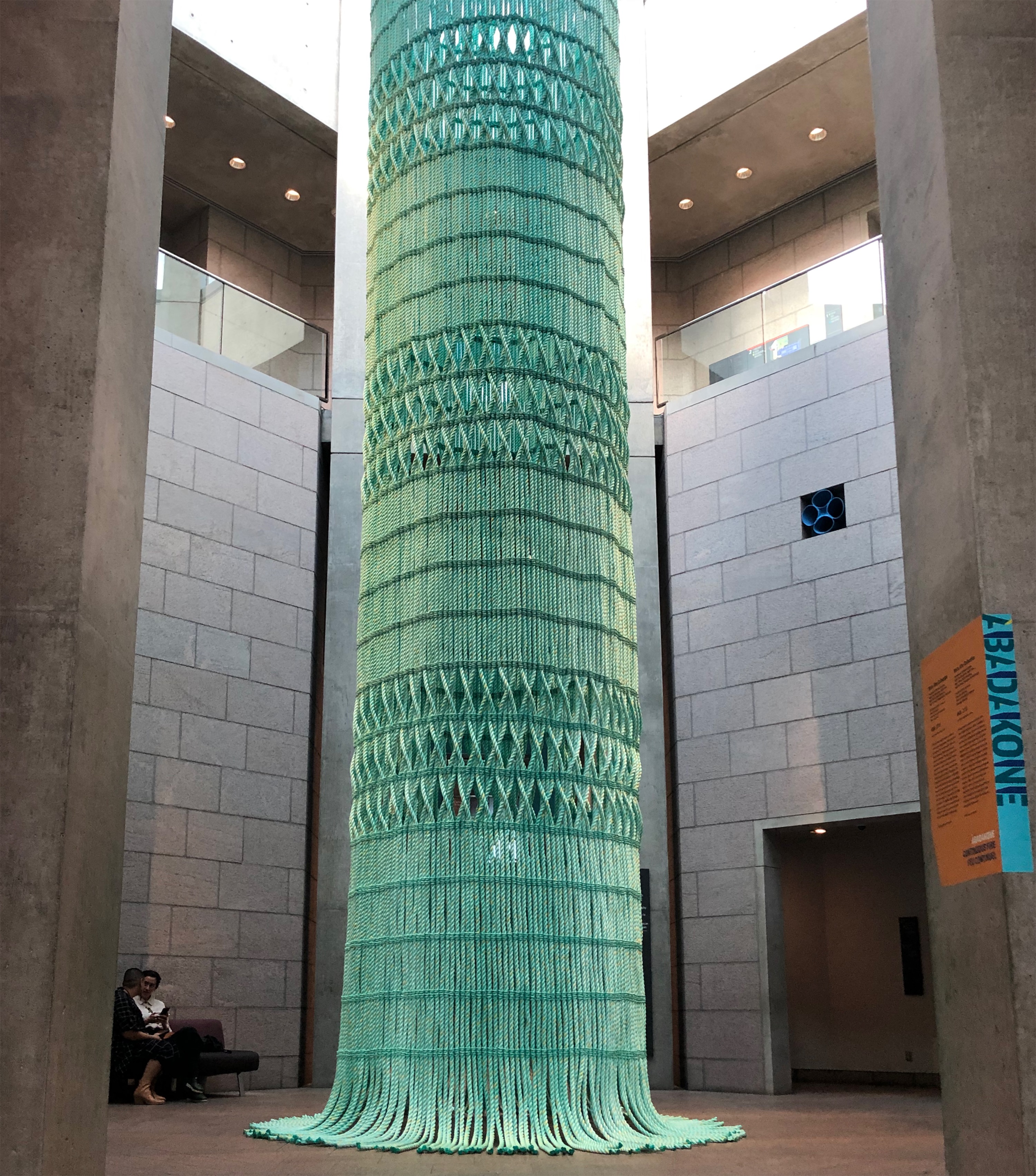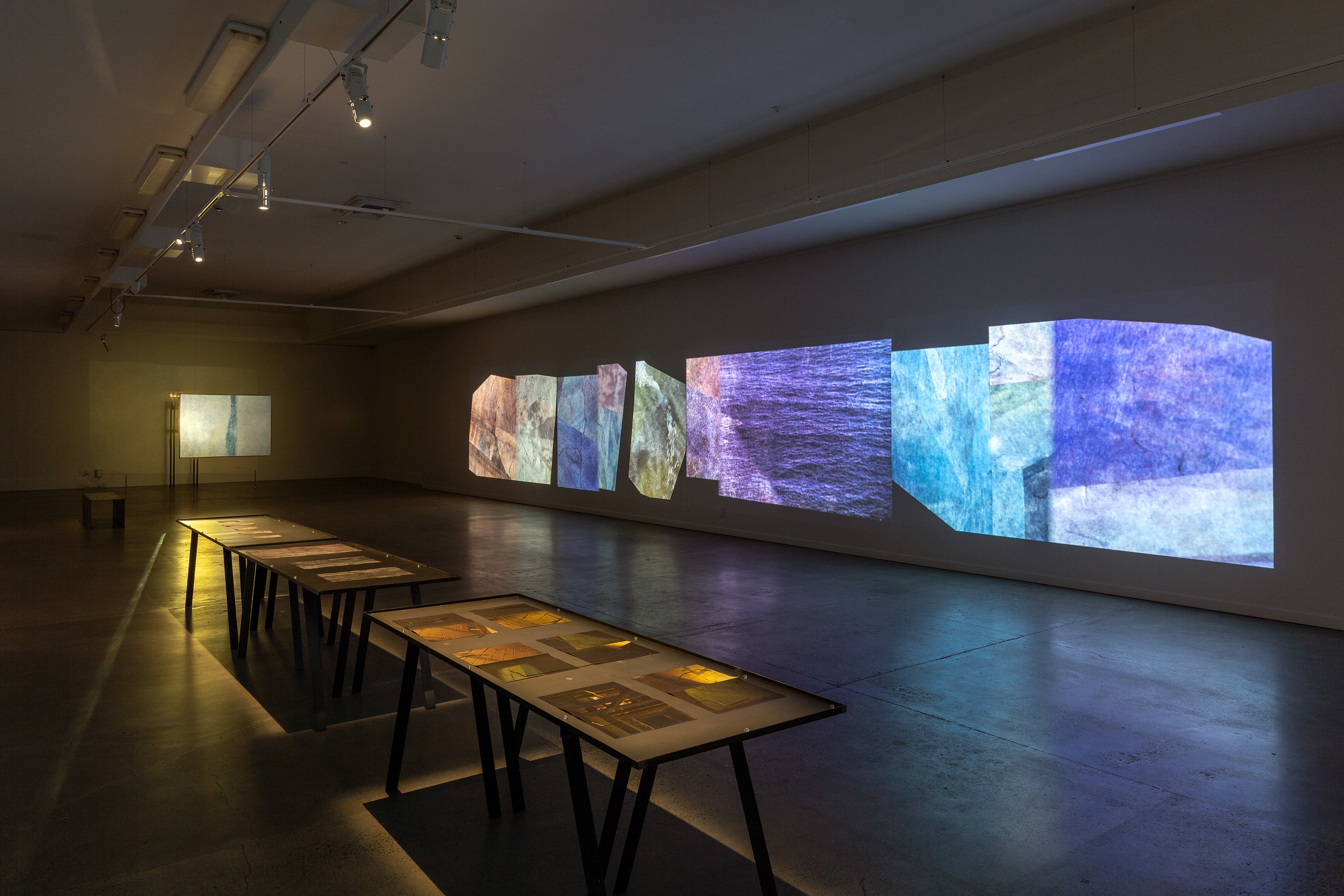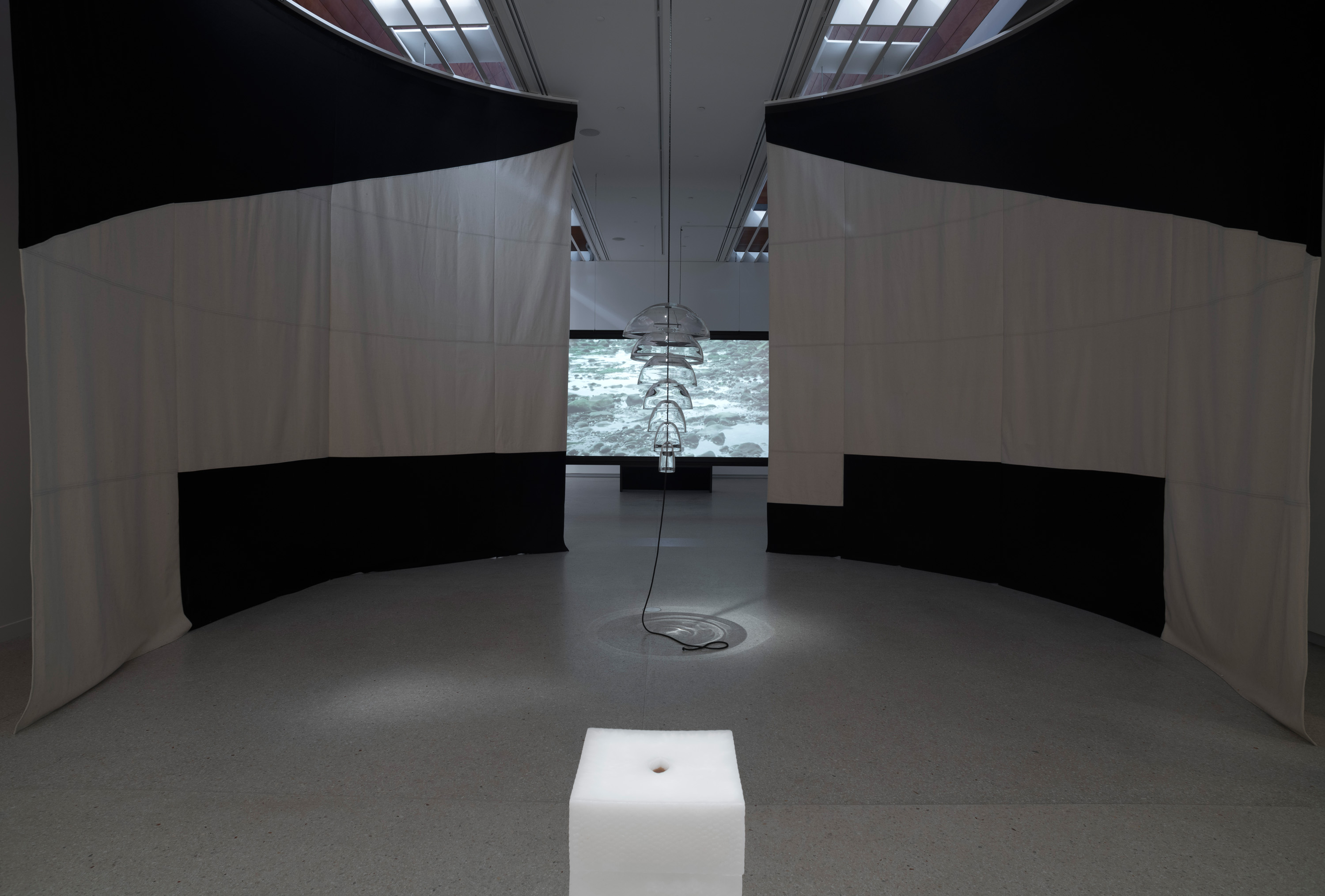Wed 8 Apr 2020
Amid its temporary closure due to Covid-19, Auckland Art Gallery Toi o Tāmaki is especially pleased to announce today the nominees for the Walters Prize 2020.
The Walters Prize is Aotearoa New Zealand’s most significant contemporary art award. Established in 2002, this year will be the tenth iteration of the Walters Prize, which was conceived as a platform to foreground excellence in the visual arts.
The jury for this year’s prize met in February to select the four nominated artworks. These artworks are selected for their outstanding contributions to contemporary art in New Zealand in the preceding two-year period.
The selected artworks are:
AKA, 2019, by the all-women, Māori art collective, Mata Aho. First exhibited in Àbadakone | Continuous Fire | Feu Continuel, National Gallery of Canada, Ottawa, 8 November 2019–5 April 2020.
A Body That Lives, 2018, by Auckland-based Fiona Amundsen. First exhibited at ST PAUL St Gallery, Auckland University of Technology, Auckland, 28 September 2018–26 October 2018.
Weekend, 2018, by Wellington-based Sonya Lacey. First exhibited in Solo, The Dowse Art Museum, Wellington, 10 November 2018–17 March 2019.
Now Spectral, Now Animal, 2019/2020 by London-based Sriwhana Spong. First exhibited at Edinburgh Art Festival, 2019 and at Auckland Art Gallery Toi o Tāmaki, 22 February–7 June 2020.
The 2020 Walters Prize jury members are:
Allan Smith, freelance curator/writer and senior lecturer, Elam School of Fine Arts, University of Auckland
Nathan Pohio, (Ngāti Māmoe, Ngāi Tahu), artist, assistant curator, Christchurch Art Gallery Te Puna o Waiwhetū
Melanie Oliver, former senior curator at The Dowse Art Museum, Lower Hutt, now curator, Christchurch Art Gallery Te Puna o Waiwhetū
Charlotte Huddleston, director, ST PAUL ST Gallery, Auckland University of Technology
Auckland Art Gallery’s commitment to the Walters Prize ensures that these nominated works, or new works created by the shortlisted artists, will be presented for the public in a forthcoming exhibition. A winner is selected from the prize exhibition and awarded NZD$50,000.
Auckland Art Gallery Director Kirsten Paisley says: ‘We are delighted to announce the nominees of the Walters Prize 2020 and to bring to the fore the achievements of these New Zealand artists over the last two years. For all these artists, their nomination is a recognition of the strength and resonance of their work and we greatly anticipate an exceptional exhibition.’
‘Due to the impact of Covid-19 on the visual arts industry, it is more important than ever that Auckland Art Gallery continues to support contemporary artists and provide platforms for the voice of artists to be heard in these uncertain times.’
Walters Prize alumni over the last 20 years now represent an active group of New Zealand artists operating on the international stage.
Auckland Art Gallery Curator, Contemporary Art, Natasha Conland says: ‘For 20 years, the Walters Prize has provided a platform for discussion and debate in New Zealand art – each year reflecting new areas of interest or focus. In 2020, the prize continues to provide visibility to artists who have demonstrated outstanding achievements in their practice within a single body of work, this time with a group of entirely women artists. We are delighted to draw attention to these nominated works, which demonstrate unique engagements with Indigenous culture and historical enquiry.’
The Walters Prize founding benefactors and principal donors are Erika and Robin Congreve, Dame Jenny Gibbs. The Auckland Contemporary Arts Trust is a principal donor. Major donors are Dayle, Lady Mace, and Chris and Charlotte Swasbrook.
The Walters Prize 2020 Jury Statement
‘Given the strength of art and exhibition practices at present, selecting four finalists whose work has made an outstanding contribution to contemporary art in this two-year period proved challenging. The work of this year’s finalists addresses how histories are experienced, recounted and kept alive in the present, intergenerational and ethical relationships, and the circulation of information through various media. The particularities of each project are distinct, each advancing contemporary practice materially, conceptually and spatially.’
Mata Aho
The Mata Aho Collective was established in 2012 by Erena Baker, Sarah Hudson, Bridget Reweti and Terri Te Tau.
Erena Baker (Te Atiawa, Ngāti Toarangatira, Ngāti Raukawa) Born 1984, Palmerston North. Lives and works in Palmerston North. Masters of Māori Visual Arts with First Class Honours, Massey University, Palmerston North, 2009.
Sarah Hudson (Ngāti Awa, Ngāi Tūhoe) Born 1986, Auckland. Lives and works in Whakatāne. Masters of Fine Arts with high distinction, Massey University, Wellington, 2010.
Bridget Reweti (Ngāti Ranginui, Ngāi Te Rangi) Born 1985, Te Puke. Lives and works in Dunedin. 2020 Frances Hodgkins Fellow, University of Otago. Masters of Māori Visual Arts with First Class Honours, Massey University, Palmerston North, 2013. Post-Graduate Diploma in Museum Studies, Victoria University, Wellington, 2013.
Dr Terri Te Tau (Ngāti Kahungunu, Rangitāne ki Wairarapa) Born 1981, Sydney. Lives and works in Pōhangina Valley, Manawatū. PhD in Creative Arts from Massey University, 2015. Postdoctoral Fellow at the Center for Culture-Centered Approach to Research and Evaluation (CARE) at Massey University 2018–19.
Nominated for: AKA, 2019, a site-specific, fibre-based work formed in marine rope and steel, and exhibited in Àbadakone | Continuous Fire | Feu Continuel, an exhibition of contemporary international Indigenous art, National Gallery of Canada, 8 November 2019–5 April 2020
Jury statement:
The Mata Aho Collective is a group of four Māori women artists who produce large-scale, fibre-based works and work with a single collective authorship. The collective’s site-specific installation, AKA, 2019, is a 14-metre high, hand-woven work made from 25 millimetre-thick marine rope that was situated in the rotunda of the National Gallery of Canada. AKA, from the Māori word vine, is inspired by the narrative of the female deity Whaitiri, the personification of thunder. Combining customary whatu (finger twining) practice and modern materials, this vine provides a space for contemplation and invites viewers’ eyes to journey upwards to a place of raised consciousness. This ambitious work was selected to recognise how Mata Aho, whose work is firmly founded in mātauraunga Māori, have shifted the conversation around contemporary art through several recent projects. Working collaboratively and raising awareness of Indigenous practices and stories, Mata Aho call attention to concepts and ways of working that are often overlooked in contemporary art contexts. Focusing on the visibility of Māori women, their large-scale projects demand attention in a dramatic and inspiring way, often unfolding in the online space and shared across digital networks to reach diverse communities.
Fiona Amundsen
Born Auckland, 1973. Lives and works in Tāmaki Makaurau/Auckland. Doctor of Philosophy, Monash University, 2019. Master of Social Sciences with First Class Honours, University of Waikato, 2005.
Nominated for: A Body That Lives, 2018, a video and photographic installation with contributors Fuyuko Akiyoshi, Kayoko Ebina, Ben Kuroki, Nobuyoshi Maehira, Asumi Mizuo, Teruo Murakami, Michiko Uehara and Mami Yamada. A solo exhibition at ST PAUL St Gallery, Auckland University of Technology, Auckland, 28 September 2018–26 October 2018.
Jury statement:
Through bringing a new approach to lens-based documentary practice, Fiona Amundsen has developed a strong body of work that is ethically and politically driven, working with subjects to generate new understandings of histories and their memorialisation. A Body That Lives, 2018, brought together photography and video footage associated with the Asia-Pacific theatre in World War II, using both archival and present-day footage in a highly accomplished and deftly paced installation. Amundsen’s ethical commitment to her collaborators telling their stories is supported by the ongoing relationships she has developed in making the work, and through the device of the ‘listening’ camera. Amundsen’s reflections on the artist-filmmaker’s responsibilities reveals a sensitivity and respect presented through the raw honesty of cinema’s basic elements and this filmmaker’s humility. Joining accounts of highly personal and painful memories with archival footage which tell ‘official’ histories opens a space to consider counter-histories that complicate our understanding of narratives about the past.
Sonya Lacey
Born Hastings, 1976. Lives and works in Wellington. Master of Fine Arts, Elam School of Fine Arts, University of Auckland, 2007.
Nominated for: Weekend, 2018, four-channel moving image and mixed-media installation, The Dowse Art Museum, Wellington, 10 November 2018–17 March 2019
Jury statement:
Sonya Lacey’s installation Weekend, 2018, is a sophisticated treatment of historical source material intricately worked into a project that highlights contemporary issues around information dissemination and access to knowledge. Lacey often focuses on forms of communication and histories related to printing. This project was a form of memorial to the print workers who once bathed in the now empty and disused swimming pool in the St Bride Foundation just off London’s Fleet Street. The St Bride Foundation was a late Victorian philanthropic venture for cultivating good worker citizens and narrowing the gap between work and leisure. For Weekend, Lacey washed and bleached sheets of weekend newspapers that included imagery of water until the content dissolved, turning newsworthy images into indeterminate forms that were made into pale-coloured collages and reconfigured finally as filmic abstractions. Weekend is a beautifully realised project incorporating 16mm film, a four-channel digital film, delicate sculptural items and printed matter. This process of translation and mediation follows Lacey’s ongoing interest in the fluidity and materiality of language, and the instability of information systems.
Sriwhana Spong
Born 1979, Auckland. Lives and works in London. Master of Fine Art, Piet Zwart Institute, Rotterdam, 2015. Bachelor of Fine Arts, Elam School of Fine Arts, University of Auckland, 2001.
Nominated for: Now Spectral, Now Animal, 2019/2020, film and mixed-media installation, Edinburgh Art Festival, 2019 and Auckland Art Gallery Toi o Tāmaki, 22 February–7 June 2020.
Jury statement:
Working across film, writing, sculpture, performance and sound, Sriwhana Spong’s Now Spectral, Now Animal, 2019/2020, was selected for its unique ability to create a meaningful embodied experience for the audience – or research as knowledge to be felt, tasted, touched and endured. Spong often works with overlooked histories of women and this new work takes inspiration from a historical figure of St Teresa of Ávila (1515–1582) to prompt reflection on the gaps in our understanding of the past, questioning who can speak, who is heard and what is preserved in our public archives. Working within a cinema-space suggesting the psychedelic and the sacred, past and present avant-garde filmmakers appear drawn from for their ideas on how film holds powerful metaphysical, philosophical, poetic and political values. In Now Spectral, Now Animal, we become immersed in historical account, ceremonial offering, sublimation and transformation. As always, Spong brings a strong aesthetic to the historical material, guiding the visitor and emphasising that the control of information is a powerful, political act.




